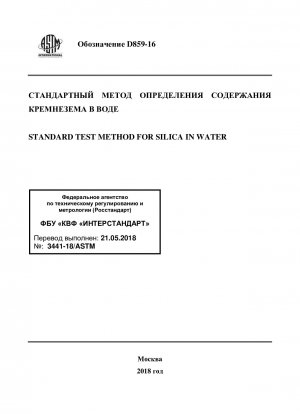ASTM D859-16
Standard Test Method for Silica in Water
- Standard No.
- ASTM D859-16
- Release Date
- 2016
- Published By
- American Society for Testing and Materials (ASTM)
- Status
- Replace By
- ASTM D859-16(2021)e1
- Latest
- ASTM D859-16(2021)e1
- Scope
5.1 Silicon comprises about 288201;% of the lithosphere and is, next to oxygen, the most abundant element. It is found as the oxide in crystalline forms, as in quartz; combined with other oxides and metals in a variety of silicates; and in amorphous forms. Silicon is the most abundant element in igneous rocks and is the characteristic element of all important rocks except the carbonates. It is the skeletal material of diatoms but is not known to play a significant role in the structure of processes of higher life forms.
5.2 Silica is only slightly soluble in water. The presence of most silica in natural waters comes from the gradual degradation of silica-containing minerals. The type and composition of the silica-containing minerals in contact with the water and the pH of the water are the primary factors controlling both the solubility and the form of silica in the resulting solution. Silica may exist in suspended particles, as a colloid, or in solution. It may be monomeric or polymeric. In solution it can exist as silicic acid or silicate ion, depending upon pH. The silica content of natural waters is commonly in the 5 to 25 mg/L range, although concentrations over 100 mg/L occur in some areas.
5.3 Silica concentration is an important consideration in some industrial installations such as steam generation and cooling water systems. Under certain conditions, silica forms troublesome silica and silicate scales, particularly on high-pressure steam turbine blades. In cooling water systems, silica forms deposits when solubility limits are exceeded. In contrast, silica may be added as a treatment chemical in some systems, for example, in corrosion control. Silica removal is commonly accomplished by ion exchange, distillation, reverse osmosis, or by precipitation, usually with magnesium compounds in a hot or cold lime softening process.
1.1 This test method covers the determination of silica in water and waste water; however, the analyst should recognize that the precision and accuracy statements for reagent water solutions may not apply to waters of different matrices.
1.2 This test method is a colorimetric method that determines molybdate-reactive silica. It is applicable to most waters, but some waters may require filtration and dilution to remove interferences from color and turbidity. This test method is useful for concentrations as low as 20 μg/L.
1.3 This test method covers the photometric determination of molybdate-reactive silica in water. Due to the complexity of silica chemistry, the form of silica measured is defined by the analytical method as molybdate-reactive silica. Those forms of silica that are molybdate-reactive include dissolved simple silicates, monomeric silica and silicic acid, and an undetermined fraction of polymeric silica.
1.4 The useful range of this test method is from 20 to 1000 μg/L at the higher wavelength (815 nm) and 0.1 to 5 mg/L at the lower wavelength (640 nm). It is particularly applicable to treated industrial waters. It may be applied to natural waters and wastewaters following filtration or dilution, or both. For seawater or brines, this test method is applicable only if matched matrix standards or standard addition techniques are employed.
ASTM D859-16 Referenced Document
- ASTM D1066 Standard Practice for Sampling Steam
- ASTM D1129 Standard Terminology Relating to Water
- ASTM D1193 Standard Specification for Reagent Water
- ASTM D2777 Standard Practice for Determination of Precision and Bias of Applicable Methods of Committee D-19 on Water
- ASTM D4841 Standard Practice for Estimation of Holding Time for Water Samples Containing Organic and Inorganic Constituents
- ASTM D5810 Standard Guide for Spiking into Aqueous Samples
- ASTM D5847 Standard Practice for Writing Quality Control Specifications for Standard Test Methods for Water Analysis
- ASTM E275 Standard Practice for Describing and Measuring Performance of Ultraviolet, Visible, and Near-Infrared Spectrophotometers
- ASTM E60 Standard Practice for Analysis of Metals, Ores, and Related Materials by Molecular Absorption Spectrometry
ASTM D859-16 history
- 2021 ASTM D859-16(2021)e1 Standard Test Method for Silica in Water
- 2016 ASTM D859-16 Standard Test Method for Silica in Water
- 2010 ASTM D859-10 Standard Test Method for Silica in Water
- 2005 ASTM D859-05 Standard Test Method for Silica in Water
- 2000 ASTM D859-00 Standard Test Method for Silica in Water

Copyright ©2024 All Rights Reserved